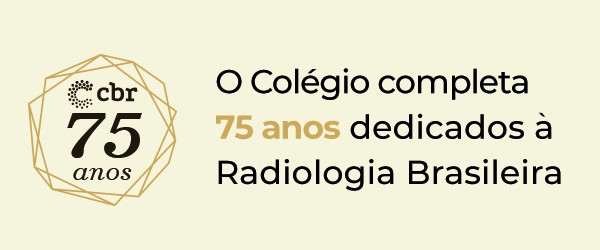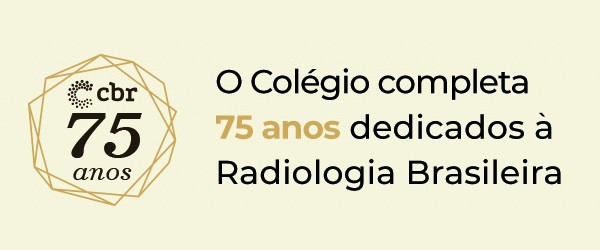The Brazilian College of Radiology and Imaging Diagnosis (CBR) reaches three quarters of a century, check out some of this trajectory

The CBR was founded in 1948, during the 1st Brazilian Radiology Conference, which took place at the Faculty of Medicine of the University of São Paulo (FMUSP), in São Paulo (SP). Since then, the College has been active for more than seven decades on behalf of radiologist doctors and Brazilian radiology.
Brazilian Radiology Congress and Imaging diagnosis:
The traditional event continues to be the main event at the College over these 75 years. However, at its beginning, the Congress had another name, it was called Jornada Brasileira de Radiologia, even the CBR was founded during the first Jornada. However, from the tenth edition onwards, the event was renamed the Brazilian Congress of Radiology. In addition to the change in name, from 1997 onwards the Congress became annual. Since the beginning of the CBR to date, 51 Congresses have been held, this year includes the 52nd edition, and will take place in Rio de Janeiro, from October 12th to 14th. In fact, in all these years the city that received and hosts the Congress the most is Rio de Janeiro, in total, 11 editions of the event were held in the wonderful city, with this year's, it will reach 12. After the capital of Rio, comes the capital of São Paulo, which hosted the event on seven occasions. Next comes Curitiba, which hosted the event six times. It is worth mentioning that the National Congress of Radiology and Imaging Diagnosis has already been held in 14 different cities in 11 different states.
Professional Defense
Since the institution's founding, issues related to Professional Defense have been part of the College's priority agendas. In the 50s and 60s, the institution defended several radiologists' demands, such as the difficulties encountered in importing radiological materials and the request to the Federal Government to create a chair of Radiology in Brazilian medical schools. Between the 70s and 80s, the College had a difficult role in the face of the financial crisis experienced at the time, which resulted in an increase in radiological film and the readjustment of fee tables. Over the years, the CBR has defended important causes, such as: The non-accreditation by the National Social Security Institute (INPS) of health homes that did not have radiologists who were members of the CBR; tax exemption on the import of x-ray devices, drafting of a bill that would regulate the activity of radiologists and not allow other specialists to advance in the restricted field of radiology, in addition to the historic negotiation with the Unified Health System (SUS).
Stay on top of CBR's social networks, follow us on Instagram , Facebook It is LinkedIn
CBR headquarters
Over the course of these 75 years, a lot has happened, including the CBR moving through a few places before establishing itself in its current headquarters. The College's first house was on Rua Sete de Abril, in 1950. Then the CBR was based on Rua Marconi, between 1951 and 1957. The third place that housed the institution was Walter Bonfim Pontes' office, located on Major Quedinho street. In 1959, the CBR headquarters were moved to Avenida Angélica. Since 1968, the College's headquarters have been located on Avenida Paulista, but not in the same building. From 2007 onwards, the institution was located at Avenida Paulista, 37, Conjunto 71, where it is still located today. In total, we have had eight headquarters in these 75 years.
Specialist title and area certificate
Between 1948 and 1968, radiologists with more than ten years of experience who wanted to join the college only needed to present their CV to become a member, while other professionals, with less than ten years of experience, took a test on a selected topic, which was evaluated by an examining board chosen by the board. In 1968, sufficiency exams were carried out for Full Member and for the granting of the Title of Specialist, with written and practical-oral tests. At that time, CBR was granted the title of Specialist in Radiology, in the sectors of Radiodiagnosis, Radiotherapy and Nuclear Medicine. From 1981 onwards, the test became annual, with multiple choice questions and an oral-practical test. Currently, according to an agreement signed with the AMB, only the CBR has the legitimacy to grant and issue a specialist title in: Radiology and Imaging Diagnosis, Interventional Radiology and Angioradiology and General UltrasonographyCertificate of area of expertise in: Bone Densitometry, Vascular Ultrasound with Doppler , Mammography, Diagnostic Neuroradiology, Therapeutic Neuroradiology and Ultrasonography in Gynecology and Obstetrics.
Medical Residency
In 1968, the 1st Brazilian Radiology Teaching Seminar was held in Rio de Janeiro (RJ). However, the CBR carried out in-depth studies on the topic only in the 70s and 80s. However, it was only in 1977 that the regulatory decree regarding Medical Residency in the country was published, and established a two-year period for the program. In the same year, the CBR monitored the accreditation of clinics and training centers with the National Medical Residency Commission. In the 1980s, the College, together with AMB, studied the approval of a minimum program for Residency, however, it was only in the 1990s that the Medical Residency Program became three years, in accordance with the guidance of the CBR itself.
Brazilian Radiology Magazine
With the aim of publishing a periodical from the institution itself, Revista Radiologia Brasileira was born in 1953. However, the first edition of RB was published only in 1958. In 1967, the magazine began to be published in the city of Rio de Janeiro ( RJ) and also have the current name. In 1980 the magazine was published again in the capital of São Paulo and in 1988 there were changes to the layout of publication. In 2001, the magazine became part of the group of periodicals indexed to Scielo, recognizing its importance.
+Read more: World Forum Trends In Ultrasound 2023 takes place virtually this month
CBR Newsletter
Over time, the College developed and expanded its work. In 1957 the first edition of the 'CBR Newsletter' was developed and published. Since its launch, until today, 414 editions of the institutional newsletter have been published. Over time, some changes were made to the editorial line. The first editorial change occurred in 1967, but it was in 1980 that the main changes came. The newsletter became a tabloid and began to be published quarterly. In 1985 new changes were made, the bulletin became monthly and its size was reduced. In 1997 it started to be printed in color and on magazine paper, and finally in 2001 it took on the magazine format presenting a new editorial line. In April 2020, the school's newsletter began to be broadcast digitally via 100%.
CBR Presidents
Dr. Cibele Carvalho (2023/2024)
Dr. Valdair Muglia (Biennium 2021/2022)
Dr. Alair Sarmet Santos (2019/2020)
Dr. Manoel de Souza Rocha (2017/2018)
Dr. Antonio Carlos Matteoni de Athayde (2015/2016)
Dr. Henrique Carrete Junior (2013/2014)
Dr. Manoel Aparecido Gomes da Silva (2010/2012)
Dr. Sebastião Tramontin (2008/2010)
Dr. Fernando Alves Moreira (Triennium 2005/2008)
Dr. Aldemir Humberto (Triennium 1999/2002 – 2002/2005)
Dr. Armando de Abreu (Biennium 1997/1999)
Dr. Jaime Ribeiro Barbosa (Biennium 1995/1997)
Dr. Luiz Karpovas (Biennium 1993/1995)
Dr. Hilton Augusto Koch (Biennium 1991/1993)
Dr. Giovanni Guido Cerri (1989/1991)
Dr. Domingos JC da Rocha (Biennium 1987/1989)
Dr. Sidney de Souza Almeida (1985/1987)
Dr. Alfredo Wallbach (Biennium 1983/1985)
Dr. Paulo Biaso Villar do Valle (1981/1983)
Dr. Vanildo José Ozelame (1979/1981)
Dr. Feres Secaf (Biennium 1977/1979)
Dr. Itazil Benício dos Santos (1975/1977)
Dr. Rubens Marcondes Pereira (1973/1975)
Dr. João Carlos Cabral (Biennium 1971/1973)
Dr. Waldemar Kischinhevsky (1970/1971)
Dr. Wilson Eliseu Sesana (1969/1970)
Dr. Abércio Arantes Pereira (1967/1969)
Dr. Antonio Ferreira Filho (Biennium 1965/1967)
Dr. Hugolino Leal de Andrade (1963/1965)
Dr. Javert Barros Belo (1961/1963)
Dr. Nicola Casal Caminha (1959/1961)
Dr. José M. Cabello Campos (Biennium 1957/1959)
Dr. José Sobrinho Gonçalves (1955/1957)
Dr. João Baptista Pulchério Filho (Biennium 1953/1955)
Dr. José M. Cabello Campos (2 years 1949/1951 | 1951-1953)




